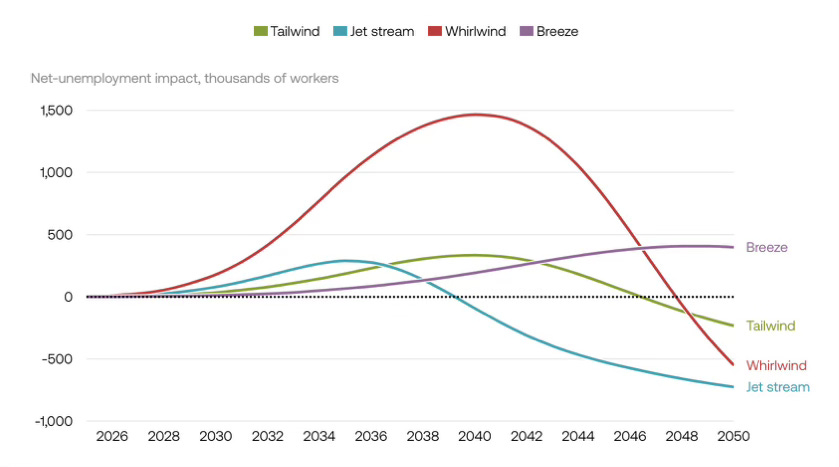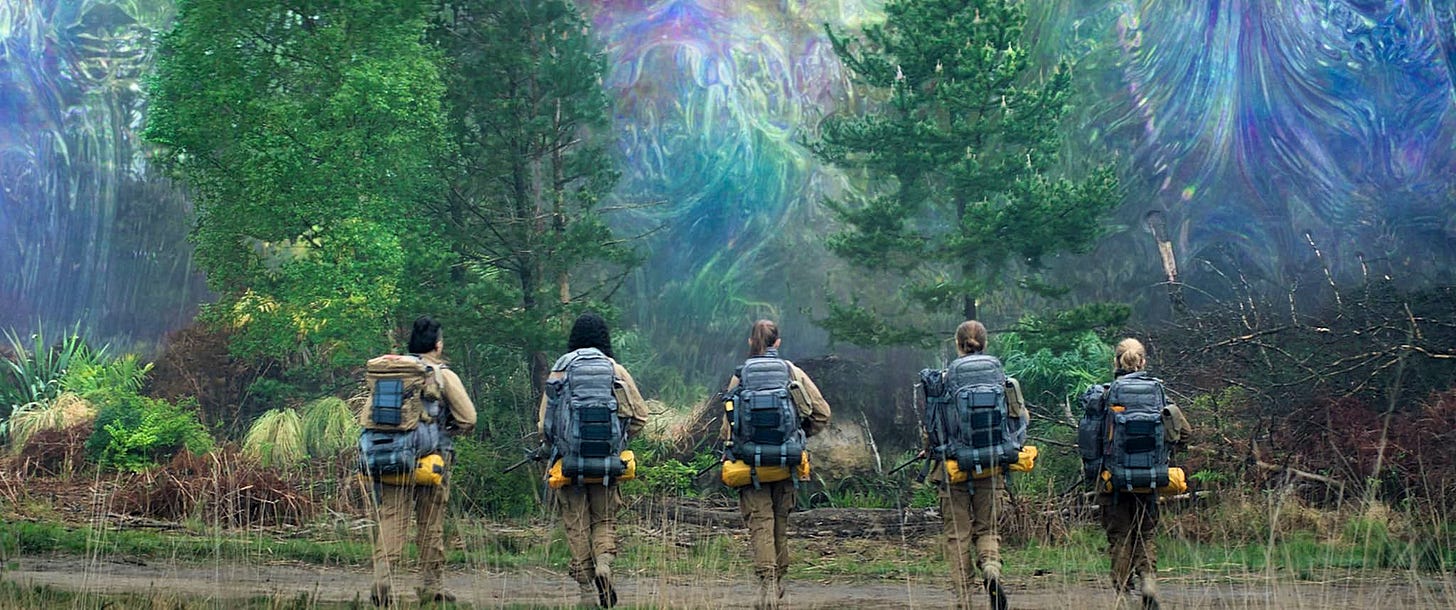The Shimmer: a metaphor for AI
Societal mutation and the film Annihilation.
Welcome to Mutant Futures: a newsletter about culture, futurism and strategy.
In this edition, I’m discussing the film Annihilation and how it works as a metaphor for the mutating effects of AI.
Let’s get into it 🔬
Recently, I rewatched Annihilation, Alex Garland’s adaptation of the 2014 novel by Jeff VanderMeer. Here’s the basic premise:
Five scientists embark on a military expedition into ‘the Shimmer’, a mysterious zone that appears in coastal Florida, after a meteor strikes there. One of the scientists, Lena, has joined the expedition to understand what happened to her husband, Kane, after he entered the Shimmer and disappeared. You see, this expedition isn’t the first—in fact, several expeditions have already taken place. But all previous teams went missing and never returned, save for one person: Kane. A year after his disappearance, he miraculously comes home to Lena. But something isn’t right. He is not the same man. And the Shimmer has something to do with it.
Annihilation deals with themes of self-destruction, identity dissolution and ecological distortion, among others. It explores what happens when biological systems stop functioning as expected and evolve into something unfamiliar, even hostile. The film is considered 'eco-horror’, a genre which presents nature not as a passive backdrop, but as an active force that retaliates against humanity’s interference. Through that lens, Annihilation confronts us with the unknown, the uncanny and the alien. And while it was released in 2018, I was struck by how zeitgeisty it feels in 2025. Not just because of its ecological themes, but because of how it captures our anxieties around a very palpable force reshaping the world: AI.
🪧 There are spoilers in this post 🪧
What is the Shimmer?
To illustrate my theory, let me start by explaining what the Shimmer actually does.1 It’s an ethereal spatial energy that acts as a prism, refracting everything within it. Not just light, but DNA as well. As a result, it influences the anatomy of all life that finds itself inside it, human and non-human. It’s neither good nor bad, but operates on its own alien logic. And its sphere of influence is constantly expanding.
The longer you stay in the Shimmer, the more you experience its mutating effects. Your memories become unreliable and your sense of identity starts to blur—here’s a snapshot from Annihilation the novel:
I am all by myself. The trees are not trees the birds are not birds and I am not me but just something that has been walking for a very long time…
Meanwhile, your body begins to do peculiar things. Your fingerprints start shifting around. On a microscopic level, your cells start dancing. In the film, the scientists discover animals with strange physical traits, like an alligator with shark teeth, a bear that mimics human cries, and forest animals with floral mutations.

So we know that the Shimmer:
Continuously absorbs and reshapes things
Assimilates human and non-human inputs, and mixes them together
Can blur the boundaries of things, until they’re unrecognisable
Operates on a non-human logic
Erodes memory and reality
Is continuously expanding
Does this sound familiar? It’s hard not to see the parallels with AI. It’s a force that’s been unleashed on the world, like the Shimmer. While it’s not an alien intelligence, it certainly doesn’t function in ways we can always comprehend (when it hallucinates for example). And we don’t know its intentions. Whether it will align itself with humanity, once it gets really going, is unclear. The more we engage with and perpetuate it, the more it mimics us, warping us in the process. If you ask me, we’ve created our own Shimmer.
Duplicates that we don’t recognise
There’s a moment near the end of Annihilation when Lena, having gone to the epicentre of the Shimmer, comes face to face with an alien duplicate of herself. A mirrored being, moving in sync with her. No aggression, just imitation. It taps into something quite unsettling: being confronted with something that reflects you, but isn’t you.
This phenomenon is something we encounter all the time with cutting-edge AI. The visual trickery of AI-generated clothing filters, the uncanny authenticity of conversational speech models, or the eerie humanity of synthetic clones. If we can no longer tell what’s purely human-made and what’s not, it’s not just creativity and reality that we’re blurring, but also identity. This raises a huge question: what does it mean to be our digital selves when we can create a carbon copy of ourselves?
The age of ouroboros
Throughout the film, a tattoo subtly appears on several characters: a snake eating its own tail (aka the ouroboros). The ouroboros is an ancient symbol of course, associated with the circle of life and death, but also self-destruction. In the context of Annihilation, it’s a product of the Shimmer and a motif throughout the film, as everyone on the expedition is struggling with some form of self-destruction:
Lena (Natalie Portman): has an extramarital affair, which contributes to Kane’s decision to join a Shimmer expedition. Her guilt and Kane’s peculiar return push her to study the Shimmer herself, as an act of marital redemption.
Ventress (Jennifer Jason Leigh): has been diagnosed with terminal cancer. Her choice to enter the Shimmer is driven by a pursuit of answers and a confrontation with the unknown before the cancer claims her life.
Anya (Gina Rodriguez): is a recovering addict. Her struggles have left her seeking purpose and an escape from her past, which she hopes the expedition will bring.
Josie (Tessa Thompson): struggles with depression and self-harm. The expedition represents an opportunity to heal and make peace with herself.
Cassie (Tuva Nuvotny): is grieving the loss of her daughter, which has left her emotionally hollow and isolated. She joins the team to move forward with her life.
Again, it’s not a stretch to see parallels between the scientists and us in this context, but with AI. Beyond the productivity benefits, we’re using it as a crutch, an escape and a source of distraction. A replacement for therapy or comfort in times of loneliness and dysfunction, when we can’t find solace in each other. But this comes at a price, to our identity and our intellect. You may have heard about the Microsoft study linking LLM use to an erosion of critical thinking, for example.
On a collective level, AI represents a self-destructive transformation of civilisation.2 It’s trained on our most profound knowledge, feeding it back to us in new forms, and this cycle is repeated over and over. And so gradually, the line between what’s human and what’s synthetic blurs a little more each time.
We’re caught in a loop where we want to resist, but also want to see what happens next. We optimise our lives with it while also fearing what it might take away. It’s a double-edged sword. Both empowering and destabilising. Exciting and worrying. It has undeniably contributed to our culture of chaos, that’s manifested itself this decade. The Akin, a strategy and research studio, has termed this period the ‘era of dissonance’. Their 2025 Changemaker Report describes this as follows:
The once-solid ground beneath our collective feet has liquefied into a state of perpetual flux, neither fully crisis nor calm, but a hyperfractured reality where opposing forces coexist without resolution.
The old structures are breaking down, but the new ones haven’t formed yet. This feeling is also captured in Annihilation:
We were neither what we had been nor what we would become once we reached our destination.
On a macro-economic level, jobs are facing obsolescence because of AI, with new ones expected, but not yet crystallised. Last November, the Tony Blair Institute released a report outlining four possible futures for AI’s impact on the UK job market. The most likely scenario according to them (see ‘Tailwind’ below) involves a relatively stable transition where AI is adopted by most employers, with unemployment impact peaking around 2040. By the 2030s, around 10% of UK firms are expected to be using AI effectively. 90% by 2050. Job losses will happen, but rather than mass layoffs, businesses are expected to retain a portion of their workforce by redistributing tasks and integrating AI into existing roles.

The report predicts that in all four scenarios, not all displaced workers will be absorbed into new jobs within their companies. So unemployment will go up, that’s a given. But that’s not as problematic as a lag between displacement and job creation. The report predicts that even in the most likely scenario (Tailwind), it could take around five years for some displaced workers to be absorbed into new roles. AI adoption promises to boost GDP growth, but it will also lead to societal turbulence. And right now, we’re not entirely sure if we’re safe from a whirlwind.
Finding ourselves in the alienation
The key to facing the Shimmer lies in curious adaptation—that’s the takeaway from Annihilation in my view. The film doesn’t end in tragedy. In fact, Lena manages to overcome the Shimmer. Not by resisting it, but by leaning into it. Her arc suggests that survival of such an all-consuming force involves letting go of who you were before it came along. AI presents us with a similar situation. It’s here to stay, and it’s already refracting and mutating aspects of humanity. Shunning it won’t stop it from expanding and reshaping the world. And so a more realistic way forward would be to explore human-AI synergies, to cultivate a net positive relationship with it. And to grow with it.
I’m aware that AI can be destructive in more ways than one. Especially GenAI, with its energy consumption and copyright infringement issues. That said, if we empower ourselves with an understanding of it now, we can push for AI futures that serve humanity beyond corporate efficiency and economic accelerationism.
With the way things are going this decade, our best adaptation strategy might be for us to anticipate and get comfortable with unnatural transformation. And that’s the ethos of this newsletter. Mutant Futures is about finding beauty in the mess and resilience in the storm. It’s about inviting futures where we experiment with change, challenge our limiting beliefs and think about how to shift with the chaos.
AI will continue to transform us, but we can be more than bystanders in this journey. We can co-create the future, while accepting that there are some things we simply can’t control. As the sci-fi legend Ursula K. Le Guin put it:
To find a new world, maybe you have to have lost one. Maybe you have to be lost. The dance of renewal, the dance that made the world, was always danced here at the edge of things, on the brink, on the foggy coast.
Thank you for reading! 💜 If you haven’t subbed already…
In the novel, the Shimmer is known as ‘Area X’ and doesn’t have the clear boundaries depicted in the film. Nor are its origins explained. There are other differences between the novel and film, but I’ll leave you to discover those for yourself.
Side-note, I couldn’t help noticing the coincidence of us being in the Year of the Snake, according to the Chinese calendar. Snakes are known to shed their skin of course. I’m not into astrology by any stretch, but this coincidence couldn’t have come at a more transformative time…







I love how themes of dystopia and cautious optimism intertwine in this great piece. This Shimmer of ours (AI) certainly seems like a destructive force, something that's alien to the human experience. But, like you point out, it's also open-ended. It invites us to enter the chaos and forge a new world out of if. Let's hope the mutant future is kind to our children.